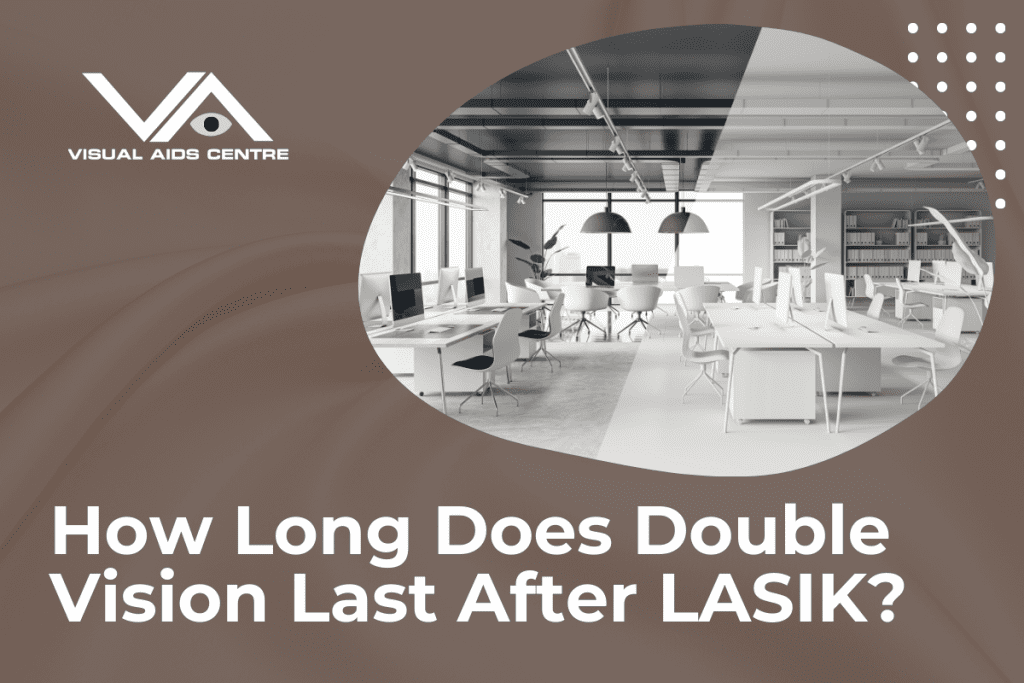Table of Contents
ToggleYou may have experienced double vision, especially after a fun party or a tough shift at work. There are many reasons for having double vision after LASIK, and we will let you know how long it lasts.

Dry Eye
Severe dry eye can cause double vision because the eye is not producing enough or quality fluid. In this case, treatment includes:
- Eye drops (which may require a prescription).
- Tear duct plugs.
- Eye vitamins.
- Improved eyelid hygiene techniques.
Cataract
Cataracts can cause double vision, especially when the patient is looking at bright lights. The eye’s natural lens behind the pupil begins to fog up, scattering light rays in different directions and creating multiple imperfect images. Laser cataract surgery usually eliminates this problem.
LASIK (Refractive Surgery)
LASIK, PRK, and other refractive surgeries can cause double vision.
Changes in the cornea can cause light rays to scatter initially rather than focus properly. Fortunately, this problem usually goes away within a few weeks or months.
Brain or Skull Problems
Stroke, head trauma, brain tumours, cerebral aneurysms, and cranial nerve palsies are less likely causes of double vision. Be sure to tell your optometrist if you’ve had a recent concussion or if you have a family history of brain tumours, diabetes, multiple sclerosis, meningitis, or high blood pressure so they can refer you to a specialist if necessary.
If you suffer from double vision or think you have another eye problem, contact a good eye care centre. An experienced professional eye doctor can help keep your eyes as healthy as possible. Don’t risk your health and safety by letting go of your problems. Please book as soon as possible.
What causes double vision?
Eyes work independently (e.g. you can close one eye and still see the other). Each eye captures its image and sends it to the brain via the optic nerve. Your brain combines these image signals into a single sharp image that perceives depth. Diplopia usually reflects a failure of this process of combining duplicated image signals.
It is important to note that double vision does not necessarily mean seeing two sharp images. Often “double” means blurry vision. For example, “ghosting” is a type of image blur that causes objects to appear almost transparent due to image overlays.
When is double vision not usually a problem?
Eye strain is associated with many other problems besides double vision, such as dry eyes, blurred vision, photosensitivity, and eye pain. Alcohol impairs brain function, leading to slurred speech and decreased motor function. Excessive alcohol consumption can damage the brain’s ability to properly combine two images, resulting in blurry or double vision.
If you occasionally experience double vision associated with any common scenarios above, this is usually nothing to worry about.
Patients undergoing refractive surgery have many postoperative examinations.
The good news for people with double vision is that many treatment options exist. Treatment depends on the underlying cause. It means that ophthalmologists must first diagnose the cause before recommending appropriate treatment. Treatments for double vision include surgery, medication, prescription changes, and vision therapy.
Changes in vision after LASIK
LASIK permanently changes vision, but there are reasons why vision changes after LASIK.
Another common reason for vision changes years after LASIK is a natural change in the eye called presbyopia. How long LASIK “lasts” depends on how old you were when you had it and how advanced your eye disease is. Most people who have had LASIK surgery are satisfied with their vision ten years later.
According to one study, 35% of those with LASIK had to undergo repeated treatments over ten years. Another study followed people with myopia or astigmatism who had LASIK. Over 12 years, about 10% of study participants experienced age-related changes in vision during that time.
Even if your vision becomes blurred again after the initial surgery for other reasons, you may still be able to have LASIK enhancement years later. It depends on how to be removed in the first procedure and how much remains.
What can I expect during LASIK? It is not painful, but the eye may be slightly pulled or squeezed.
The basic steps in the procedure are:
- Eyes are held open by eyelid retractors.
- Insert a flap into the cornea’s outer layer using a small blade or laser. At this time, you may feel pressure or discomfort.
- Conventional (Blade) LASIK. A device called a microkeratome is attached to the eye. It consists of a ring attached to a tiny blade. Lift the callus with ring suction and cut the lobes with a sword.
- All Laser LASIK. A femtosecond laser sends a pulse of energy toward the cornea, gently lifting the outer layer of the cornea. Then make the cuts and make the flaps.
- The flaps will rise gently.
- Excimer laser. It is used to remove tissue from the callus. The amount withdrawn is based on your glasses or contact prescription.
- Custom (Wavefront) Laser
- It uses light waves to analyse the features of the eye and create a detailed eye map.
- Eyes may become itchy and burn immediately after treatment. Visibility is blurry at first but should clear up the next day.
- Eye drops are prescribed to keep your eyes healing and moist. It also comes with an eye shield to cover and protect your eyes.
It usually takes 2-3 months for the eye to heal completely and the vision to stabilise. Until then, do not wear contact lenses or eye makeup.













